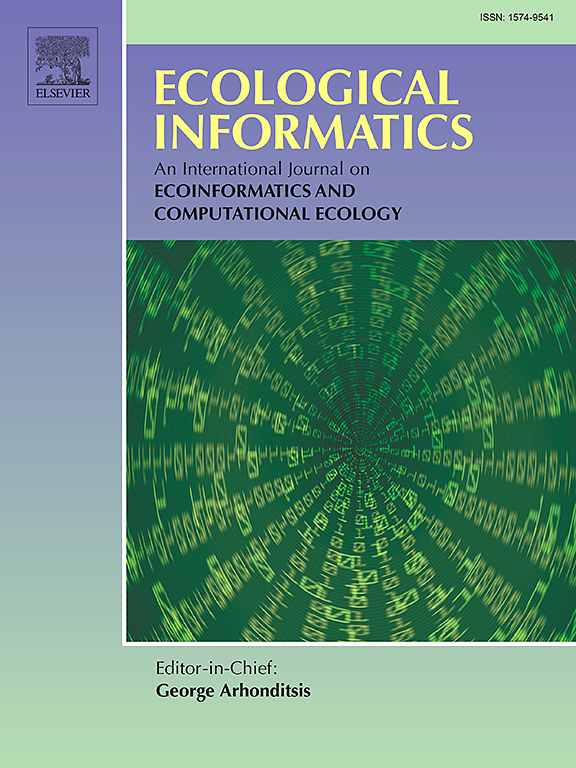改变鳄鱼的可追溯性:识别暹罗鳄的深度度量学习
IF 5.8
2区 环境科学与生态学
Q1 ECOLOGY
引用次数: 0
摘要
本研究介绍了一种识别暹罗鳄()个体的新方法,这是保护和可持续产业实践的关键要求。虽然深度度量学习(DML)提高了识别模型的鲁棒性并降低了对大型数据集的依赖性,但仍缺乏全面的实地研究和长期部署。为解决这一问题,我们将 DML 与卷积神经网络(CNN)相结合,利用每类有限且不平衡的图像数量来提高准确性,并区分头部和腹部区域的不同尺度模式。根据提取的特征,使用 k 近邻(KNN)和支持向量机(SVM)分类器识别鳄鱼个体。利用连续两年拍摄的照片收集了鳄鱼养殖场中 30 条鳄鱼的数据。我们采用了两种识别类型:类型 1(基于两年来收集的图像所训练的模型)和类型 2(基于第一年的图像所训练的模型)。第 1 类识别使用了 CNN 与 KNN 和 SVM 分类器,其腹部和头部区域的准确率分别超过 99.75% 和 92.93%。由于学习信息量相对较少,第二类识别的准确率有所降低;使用 KNN 和 SVM 进行腹部识别时,拟议的 CNN 的准确率为 83.99%,头部识别的准确率分别为 67.14% 和 65.61%。这项研究强调了 DML 和 CNN 在处理小型不平衡数据集以识别鳄鱼个体方面的功效,对鳄鱼行业的可追溯性和保护措施具有重要意义。本文章由计算机程序翻译,如有差异,请以英文原文为准。
Transforming crocodile traceability: Deep metric learning for identifying Siamese crocodiles
This study introduces a novel method for identifying individual Siamese crocodiles (), which is a crucial requirement for conservation and sustainable industry practices. Although deep metric learning (DML) has improved identification model robustness and reduced dependency on large datasets, comprehensive field studies and long-term deployments are lacking. To address this, DML combined with convolutional neural network (CNN) was applied for enhancing accuracy using a limited and imbalanced number of images per class and distinguishing dissimilar scale patterns of the head and ventral regions. Individual crocodiles were identified using the k-nearest neighbor (KNN) and support vector machine (SVM) classifiers based on the extracted features. Data were collected from 30 individuals on a crocodile farm using photographs taken over two consecutive years. Two identification types, Type 1, based on a model trained on images collected over two years; and Type 2, based on a model trained exclusively on images from the first year, were implemented. Type 1 identification, which used a CNN combined with the KNN and SVM classifiers, exhibited an accuracy exceeding 99.75 and 92.93% for the ventral and head regions, respectively. Type 2 identification exhibited a reduced accuracy because of a comparatively smaller amount of learning information; the proposed CNN achieved 83.99% accuracy for ventral identification and 67.14 and 65.61% for head identification with KNN and SVM, respectively. This study underscores the efficacy of DML and CNN for handling small, imbalanced datasets in identifying individual crocodiles, and has significant implications for traceability and conservation initiatives in the crocodile industry.
求助全文
通过发布文献求助,成功后即可免费获取论文全文。
去求助
来源期刊

Ecological Informatics
环境科学-生态学
CiteScore
8.30
自引率
11.80%
发文量
346
审稿时长
46 days
期刊介绍:
The journal Ecological Informatics is devoted to the publication of high quality, peer-reviewed articles on all aspects of computational ecology, data science and biogeography. The scope of the journal takes into account the data-intensive nature of ecology, the growing capacity of information technology to access, harness and leverage complex data as well as the critical need for informing sustainable management in view of global environmental and climate change.
The nature of the journal is interdisciplinary at the crossover between ecology and informatics. It focuses on novel concepts and techniques for image- and genome-based monitoring and interpretation, sensor- and multimedia-based data acquisition, internet-based data archiving and sharing, data assimilation, modelling and prediction of ecological data.
 求助内容:
求助内容: 应助结果提醒方式:
应助结果提醒方式:


